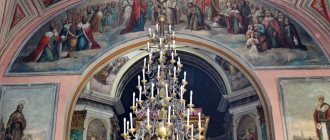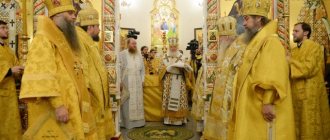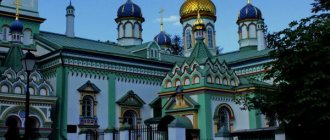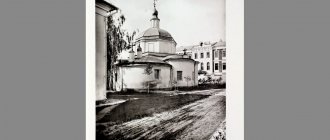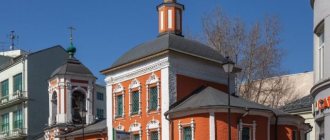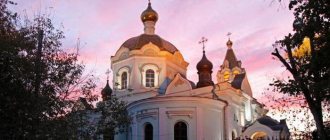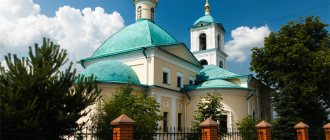Mir
Russia Moscow Church of St. Nicholas in Khamovniki (Moscow) Map is loading...
{"format":"leaflet","minzoom":false,"maxzoom":false,"limit":50,"offset":0,"link":"all","sort":[""], "order":[],"headers":"show","mainlabel":"","intro":"","outro":"","searchlabel":"\u2026 \u0441\u043b\u0435\ u0434\u0443\u044e\u0449\u0438\u0435 \u0440\u0435\u0437\u0443\u043b\u044c\u0442\u0430\u0442\u044b","default":"","import-annotation":false,"width ":"auto","height":"350px","centre":{"text":"","title":"""link":"","lat":55.731999999999999317878973670303821563720703125,"lon": 37.59150000000000346744855050928890705108642578125,"icon":""},"title":"","label":"","icon":"","lines":[],"polygons":[],"circles":[ ],"rectangles":[],"copycoords":false,"static":false,"zoom":8,"defzoom":14,"layers":["OpenStreetMap"],"image layers":[] ,"overlays":[],"resizable":false,"fullscreen":true,"scrollwheelzoom":true,"cluster":false,"clustermaxzoom":9,"clusterzoomonclick":true,"clustermaxradius":80, "clusterspiderfy":true,"geojson":"","clicktarget":"","showtitle":true,"hidenamespace":false,"template":"","userparam":"","activeicon": "","pagelabel":false,"ajaxcoordproperty":"","ajaxquery":"","locations":[{"text":"\u003Cb\u003E\u003Ca href=\"/palomnik/%D0% A5%D1%80%D0%B0%D0%BC_%D1%81%D0%B2%D1%8F%D1%82%D0%B8%D1%82%D0%B5%D0%BB%D1%8F_% D0%9D%D0%B8%D0%BA%D0%BE%D0%BB%D0%B0%D1%8F_%D0%B2_%D0%A5%D0%B0%D0%BC%D0%BE%D0% B2%D0%BD%D0%B8%D0%BA%D0%B0%D1%85_(%D0%9C%D0%BE%D1%81%D0%BA%D0%B2%D0%B0)\» title =\»\u0425\u0440\u0430\u043c \u0441\u0432\u044f\u0442\u0438\u0442\u0435\u043b\u044f \u041d\u0438\u043a\u043e\u043b\u0430\u044 f\u0432\u0425\u0430\ u043c\u043e\u0432\u043d\u0438\u043a\u0430\u0445 (\u041c\u043e\u0441\u043a\u0432\u0430)\»\u003E\u0425\u0440\u0430\u043c \u0441 \u0432\u044f\u0442\ u0438\u0442\u0435\u043b\u044f \u041d\u0438\u043a\u043e\u043b\u0430\u044f \u0432 \u0425\u0430\u043c\u043e\u0432\u043d\u0438\u 043a\u0430\u0445 (\u041c\u043e \u0441\u043a\u0432\u0430)\u003C/a\u003E\u003C/b\u003E\u003Chr /\u003E\u003Ca href=\"/palomnik/%D0%A1%D0%B2%D0%BE%D0% B9%D1%81%D1%82%D0%B2%D0%BE:%D0%90%D0%BD%D0%BD%D0%BE%D1%82%D0%B0%D1%86%D0%B8 %D1%8F\» title=\»\u0421\u0432\u043e\u0439\u0441\u0442\u0432\u043e:\u0410\u043d\u043d\u043e\u0442\u0430\u0446\u0438\u044f\»\u003E\ u0410\u043d\u043d\u043e\u0442\u0430\u0446\u0438\u044f\u003C/a\u003E: \u043f\u0440\u0430\u0432\u043e\u0441\u043b\u0430\u0432\ u043d\u044b\u0439\u0445 \u0440\u0430\u043c \u0432 \u0446\u0435\u043d\u0442\u0440\u0435 \u041c\u043e\u0441\u043a\u0432\u044b, \u0440\u044f\u0434\u04 3e\u043c\u0441\u043e\u0441\ u0442\u0430\u043d\u0446\u0438\u0435\u0439 \u043c\u0435\u0442\u0440\u043e \u00ab\u041f\u0430\u0440\u043a \u041a\u0443\u043b\u0 44c\u0442\u0443\u0440\u044b\ u00bb \u0438 \u0424\u0440\u0443\u043d\u0437\u0435\u043d\u0441\u043a\u043e\u0439 \u043d\u0430\u0431\u0435\u0440\u0435\u0436\u0 43d\u043e\u0439","title" :»\u0425\u0440\u0430\u043c \u0441\u0432\u044f\u0442\u0438\u0442\u0435\u043b\u044f \u041d\u0438\u043a\u043e\u043b\u0430\u044 f\u0432\u0425\u0430\u043c \u043e\u0432\u043d\u0438\u043a\u0430\u0445 (\u041c\u043e\u0441\u043a\u0432\u0430)”,”link”:”””lat”:55.73199999999999931787897367030 3821563720703125,"lon":37.59150000000000346744855050928890705108642578125," icon":""}],"imageLayers":[]}
55.732043; 37.591476
Russia, Moscow, Timur Frunze street, 1/2с1
Moscow
Russia
Telephone
: (499) 246-72-08 - temple,
Church of St. Nicholas the Wonderworker in Khamovniki
- an Orthodox church in the center of Moscow, next to the Park Kultury metro station and Frunzenskaya Embankment.
History[[edit]h2>
The first mention of a wooden church dates back to 1625; in 1657 it was already made of stone, and in 1677 the church was already named by its full name, “St. Nicholas the Wonderworker at the Metropolitan’s Stables.”
The current church was founded somewhat apart from the original one on May 21, 1679 under Tsar Fyodor Alekseevich, and the consecration of the main temple took place on June 25, 1682. A single-pillar refectory with side chapels and a bell tower were added later.
In 1812, during the Patriotic War of 1812, the interior of the building was partially destroyed, but was restored by 1849. In 1845, wall paintings appeared in the temple. At the beginning of the 19th century, a fence and gate were erected.
The temple was restored in 1896, 1949 and 1972. Remained active all the time. From 1912 until his death in 1960, Candidate of Theology Archpriest Pavel Lepyokhin (1880−1960) served there continuously.
In 1992, a bell weighing 108 pounds was raised to the bell tower.
In 2008, the Church of St. Nicholas in Khamovniki celebrated the 160th anniversary of the transference and glorification under its arches of the miraculous image of the Mother of God “Helper of Sinners.”
Chronicle of the shrine
Khamovniki is an ancient district of the capital, the former outskirts of Moscow in the 16th century. The suburban area with vast meadows where artisans settled was called Khamovna. Prosperous weavers lived here, producing high-quality white linen - “ham-len” – for the royal court.
By the way, later the word “boor” was associated with low-class people, and even later – with rude, ill-mannered people; the word was no longer used in its original meaning.
Nicholas the Wonderworker their patron saint and turned to him prayerfully, asking for help in work and in everyday life. In 1679, with the personal funds of artisan weavers, a stone temple was founded in Khamovnaya Sloboda on the site of a former wooden church. The brick building was named the Church of St. Nicholas the Wonderworker in Khamovniki.
For a century and a half, the temple avoided troubles, but during the war with Napoleon, during the fire of Moscow in 1812, the church burned out. By the middle of the century, the temple was restored, a fence and gates were built, and the interior was decorated with paintings. From then until our time, the church has remained unchanged.
The church survived the revolution of 1917 calmly. Located on the route of the state highway, the church remained untouched during the construction of Komsomolsky Prospekt. What helped save the temple from destruction remains a mystery. Perhaps he really is patronized by St. Nicholas the Wonderworker.
The church was not damaged during the Great Patriotic War either; the church was repaired in 1949 and restored three times in subsequent years. Divine services were not interrupted here. In 1992, a bell weighing 1800 kg , removed in the 30s, was returned to the bell tower.
Current state[[edit]h2>
Today the rector of the church is the vicar of His Holiness Patriarch of Moscow and All Rus' Kirill, Bishop of Podolsk Tikhon (Zaitsev). Today, the church operates a Sunday school and a youth group, which was organized in the spring of 2010, with the blessing of the rector, His Eminence Bishop Tikhon.
Currently, the youth group consists of 29 people. Meetings are held weekly on Saturdays at 15:00 in the church premises. After the meetings, members of the youth group take part in evening worship in the church, as well as in the Divine Liturgy on Sundays and holidays.
For informal communication, discussion and coordination of work, a group was created on the social network “VKontakte” - “Youth group of the Church of St. Nicholas in Khamovniki.” It hosts interactive discussions of work plans, meeting times and other current issues related to the activities of the youth group in the parish, photographs from various events, pilgrimages and excursions are posted.
As part of the youth group meetings, joint tea parties are held, discussions of various problems of church and public life, viewing and discussion of feature films on current issues of church and public life. Group members take part in social services carried out by the parish.
Schedule of services in the Church of St. Nicholas
Strictly speaking, a church day begins in the evening of the previous date and ends in the afternoon.
In the Church of St. Nicholas, both evening and daytime services are performed daily:
- daily Vespers begins at 17.00;
- daily liturgy - at 8.00;
- the exception is Sundays and days of great church holidays - then the liturgy is served both from 7.00 and 10.00;
- on Tuesdays, Vespers is dedicated to the icon of the Most Holy Theotokos, Helper of Sinners;
- on Thursdays Vespers is dedicated to St. Nicholas;
- On Sundays, not only Vespers, but also Matins are served to the Savior.
Advice! The schedule of services of this temple can be found on the official website of the temple: nikola-khamovniki.ru. There you can also see messages about changes in the schedule, for example, in connection with the arrival of the Patriarch and other bishops.
Shrines[[edit]h2>- Icon of the Mother of God “Helper of Sinners”
The image was kept in the Nikolo-Odriny Monastery, in the Oryol province. This icon was forgotten by everyone until the wife of one merchant, whose son was subject to severe seizures, came to the monastery and asked to serve a prayer service in front of the image of the “Helper of Sinners.” A prayer service was served, after which the sick two-year-old child recovered. After the incident, the icon was transferred to the monastery church, where in the future it repeatedly showed its miraculous power to those praying, and to this day it is kept in the St. Nicholas Monastery.
But in the Nikolo-Khamovnichesky Church there was a different image. In 1846, a hieromonk was sent from the Oryol monastery to Moscow to make a chasuble for the miraculous icon in the capital. He was sheltered by Lieutenant Colonel D.N. Boncheskul. Wanting to thank the owner for the hospitality shown, the hieromonk sent him a copy of the miraculous image, which was placed in the home icon case along with other icons. Soon people began to flock to this list from everywhere and received healing from the miraculous image.
An extraordinary shine and drops of oily moisture were noticed on the icon. They began to anoint the sick with this world, after which they became healthy. Seeing the miracles that occurred from the image, Dmitry Boncheskul donated the icon “Supportress of Sinners” to the St. Nicholas Church in Khamovniki.
- Icon of St.
Alexia (1688, isographer Ivan Maksimov)
- List of the Smolensk Icon of the Mother of God
(XVII century)
- Martyr icon.
John the Warrior (XVIII century)
The temple at present
Today, the Church of St. Nicholas the Wonderworker in Moscow, whose miraculous icons are capable of creating amazing things, is operating successfully. The large congregation is the main evidence of this. Parishioners can visit the shrine on any convenient day and bow their heads before the icons, as well as communicate with the clergy and receive valuable advice.
Interesting! Where are the relics of St. Seraphim of Sarov.
Andrei Ovchinnikov was appointed rector, who monitors the spiritual life of the parishioners.
There is a Sunday school at the temple, which anyone can attend. The youth who attend the school not only learn biblical truths, but also engage in significant social work. Reports on the activities of young people and teachers can be found on social networks on the organization’s pages, for example, VKontakte.
In addition to regular classes, at Sunday school young people meet with their mentors on weekdays. On the territory of the temple, tea parties and discussions of upcoming events, planning for the organization of Christian holidays are often held.
This is interesting! On major church holidays, many low-income people gather at the church to receive food. The ministers set the tables especially for them, thus paying tribute to the Lord and showing mercy to their neighbors.
People in need of help and repentance come to the temple:
- seriously ill;
- women who constantly pray for the recovery of their children or relatives;
- those who have lost loved ones and the meaning of life, who want to restore their mental balance;
- inconsolable parents who have lost their children;
- those who have lost interest in life and who have thoughts of suicide.
Original architecture
The Church of St. Nicholas the Wonderworker in Khamovniki, built in the Moscow Baroque style of the 17th century, has extremely interesting architecture. The church complex includes a five-domed church , a refectory, and an octagonal hipped bell tower. Moscow marveled at the strength and beauty of the temple and brought reverence and love here.
Church
The brick temple, decorated with white stone and red-green tiles, retained the features of ancient Russian architecture - uzorochya . What makes the temple unusual and memorable is its bright coloring: a colorful carpet of decorative elements spreads across the white walls. “A riot of colors” is an artistic technique by which the outside of the church resembles a ship.
The central façade is decorated with columns recessed into the wall and colorfully painted. The semicircular ends of the walls of the building - zakomaras and kokoshniks placed in a row above them (semicircular decorative elements on the vaults) visually direct the building upward. Drums decorated with colored belts look solemn and elegant under the cover of multi-colored kokoshniks. The side facades have elegant portals.
The windows framed with carved motley frames in the form of a crown look amazing. The bright colors of the typesetting elements contrast with the white walls. Multi-colored platbands, tiled inserts and overlays, elegant drum belts, a frieze under the roof of the refectory - everything is made of geometrically correct figures.
On the central head there is a large, richly decorated cross with a set of symbols: an oblique crossbar (the foot of the Last Judgment), strongly developed trefoils (a reminder of the Holy Trinity), a crown crowning the cross (a sign that a royal person has visited the temple), a crescent at the base symbolizes cup.
Bell tower
The festive splendor of the temple is emphasized by the bell tower, which creates a single composition with it. The architects tried to complicate the belfry. A two-tier hipped bell tower with a blind first tier. The second tier is octagonal, consisting of arched openings. The three-tier tent is decorated with flies and tiled inserts, and there are dormer windows in each tier.
The brick patterned decoration of the 32 windows with a slightly elongated frame enhances the upward tendency of the tent. The continuous pattern of tiles displays such beauty that it is worthy of the fabrics woven by skilled weavers.
The golden domes of the tallest bell tower in Moscow, sparkling in the sun, look like burning candles. The porches of the bell tower are arranged in the form of petals, diverging in different directions.
Luxurious interior
The entrance to the temple is through the bell room. The dome and walls are richly painted, stucco with scenes from the earthly life of Jesus Christ, Old Testament scenes and images of seraphim. In the center of the composition is the Holy Trinity with the angels standing above the altar.
Paintings in the temple are everywhere where there are no icons, cornices and stucco moldings with intricate ornaments. The four-tiered gilded iconostasis harmonizes with the golden-blue tones of the wall paintings. In the center of the iconostasis is the image of St. Nicholas the Wonderworker, the heavenly Intercessor who performed many miracles and was especially revered by the people.
In 1848, the miraculous icon “Support of Sinners” appeared in the church. The surety for sinners before the Lord has been in the temple for 160 years. Believers pray in front of the shrine for healing, for deliverance from despair and despondency, for the granting of repentance.
A list of the icon, copied from an image kept in the St. Nicholas Odrina Monastery in the Oryol province, was brought to the Khamovnichesky Church by a wealthy merchant. Soon people began to notice the light emanating from the icon. At the request of the donor, the image was not decorated with vestments, so as not to hide the outflow of grace.
Shrines of the Church of St. Nicholas
Valuable shrines are kept in the temple:
- The miraculous icon of the Mother of God “Helper of Sinners.” In 1847, during the cholera epidemic that was raging in Rus', people prayed in front of the icon for deliverance from the infection. The day after his enthronement, Patriarch Alexy II prayed before the icon.
- Icon of St. Alexis, Metropolitan of Moscow.
- Icon of the Mother of God "Smolensk".
- Icon of the Mother of God “Vladimir”
- Icon of the Mother of God “Quench My Sorrows.”
- Icon of the Mother of God “Quick to Hear”.
- Icon of the Mother of God “Three-Handed”.
- Icon of the martyr John the Warrior.
- Reliquary with particles of the relics of the saints of God.
